Leadership and HRM Strategies: Amazon Case Study Report
VerifiedAdded on 2022/10/12
|17
|4627
|3
Report
AI Summary
This report delves into the human resource management practices of Amazon, examining its performance management system and its impact on overall company performance. It explores the application of management and leadership theories, such as the Great Man theory and behavioral theory, within Amazon's organizational structure, highlighting their influence on strategic direction and leadership development. The report also evaluates the planning phases for leadership skill development at Amazon. Furthermore, it touches upon the relationship between human resource management and organizational behavior, using Starbucks as a secondary case study to determine strategies for enhancing organizational behavior and human resource management. The analysis incorporates insights from various resources, including articles, videos, and journal publications, to provide a comprehensive understanding of HRM at these prominent companies.
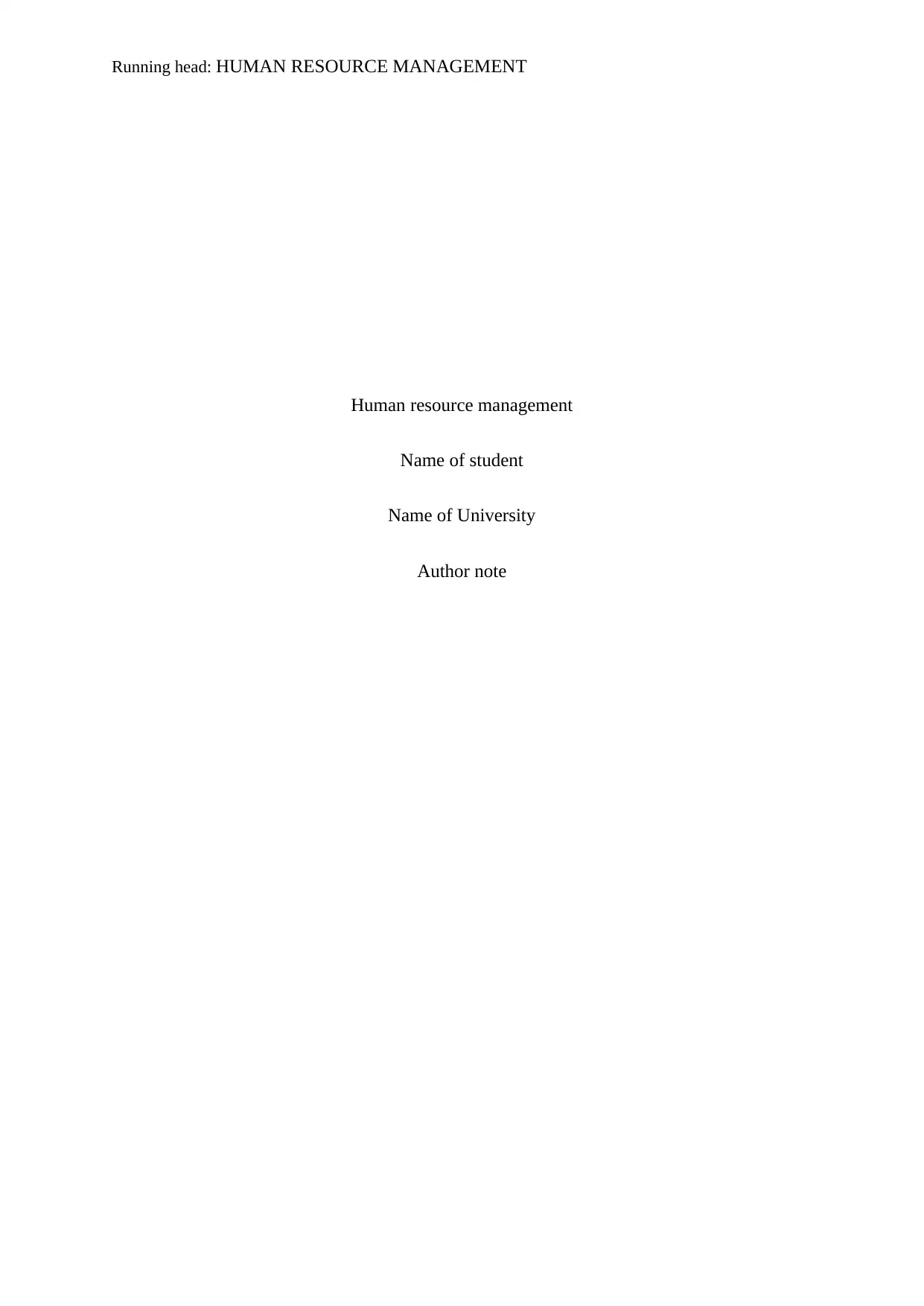
Running head: HUMAN RESOURCE MANAGEMENT
Human resource management
Name of student
Name of University
Author note
Human resource management
Name of student
Name of University
Author note
Paraphrase This Document
Need a fresh take? Get an instant paraphrase of this document with our AI Paraphraser
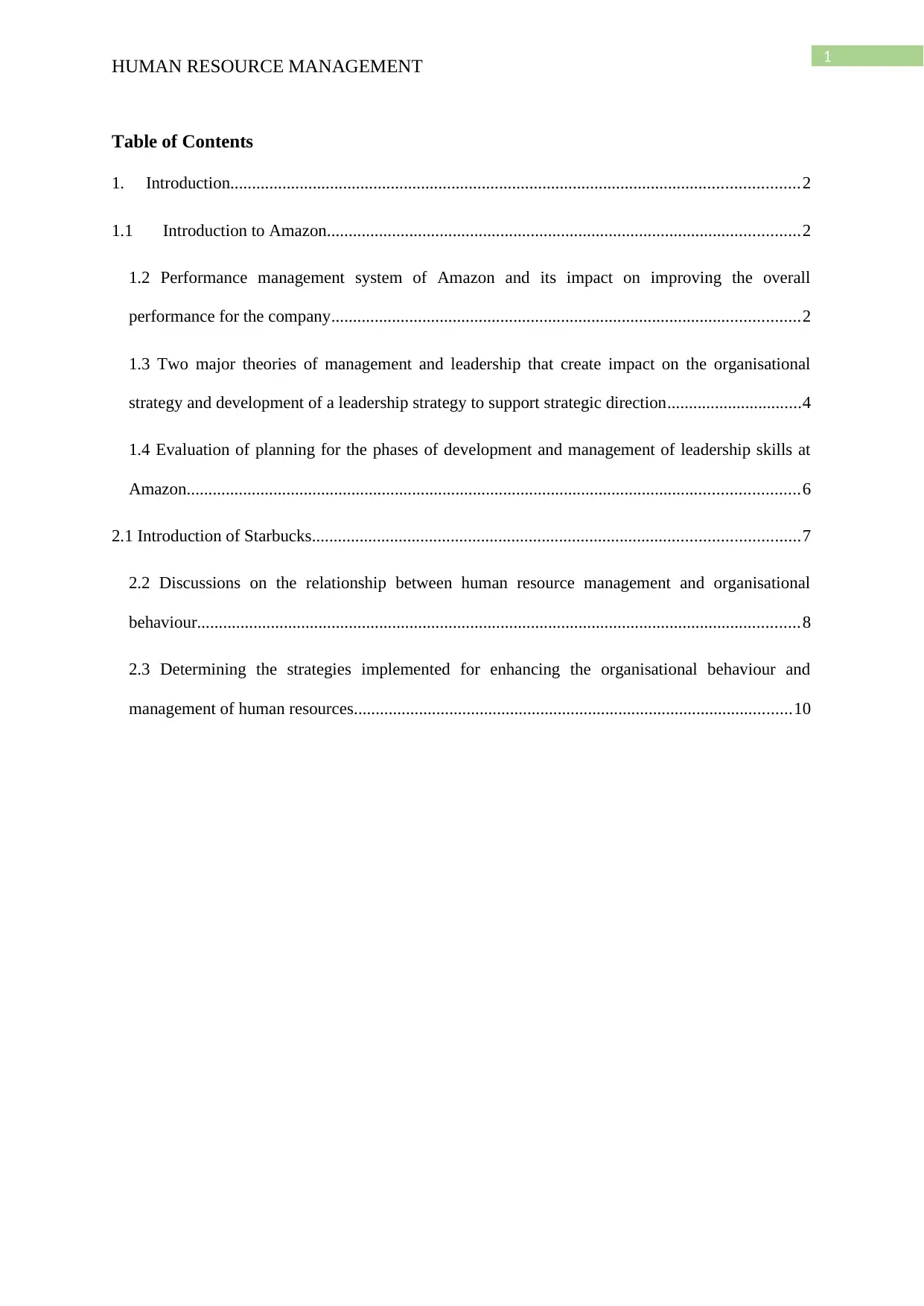
1
HUMAN RESOURCE MANAGEMENT
Table of Contents
1. Introduction...................................................................................................................................2
1.1 Introduction to Amazon.............................................................................................................2
1.2 Performance management system of Amazon and its impact on improving the overall
performance for the company............................................................................................................2
1.3 Two major theories of management and leadership that create impact on the organisational
strategy and development of a leadership strategy to support strategic direction...............................4
1.4 Evaluation of planning for the phases of development and management of leadership skills at
Amazon.............................................................................................................................................6
2.1 Introduction of Starbucks................................................................................................................7
2.2 Discussions on the relationship between human resource management and organisational
behaviour...........................................................................................................................................8
2.3 Determining the strategies implemented for enhancing the organisational behaviour and
management of human resources.....................................................................................................10
HUMAN RESOURCE MANAGEMENT
Table of Contents
1. Introduction...................................................................................................................................2
1.1 Introduction to Amazon.............................................................................................................2
1.2 Performance management system of Amazon and its impact on improving the overall
performance for the company............................................................................................................2
1.3 Two major theories of management and leadership that create impact on the organisational
strategy and development of a leadership strategy to support strategic direction...............................4
1.4 Evaluation of planning for the phases of development and management of leadership skills at
Amazon.............................................................................................................................................6
2.1 Introduction of Starbucks................................................................................................................7
2.2 Discussions on the relationship between human resource management and organisational
behaviour...........................................................................................................................................8
2.3 Determining the strategies implemented for enhancing the organisational behaviour and
management of human resources.....................................................................................................10
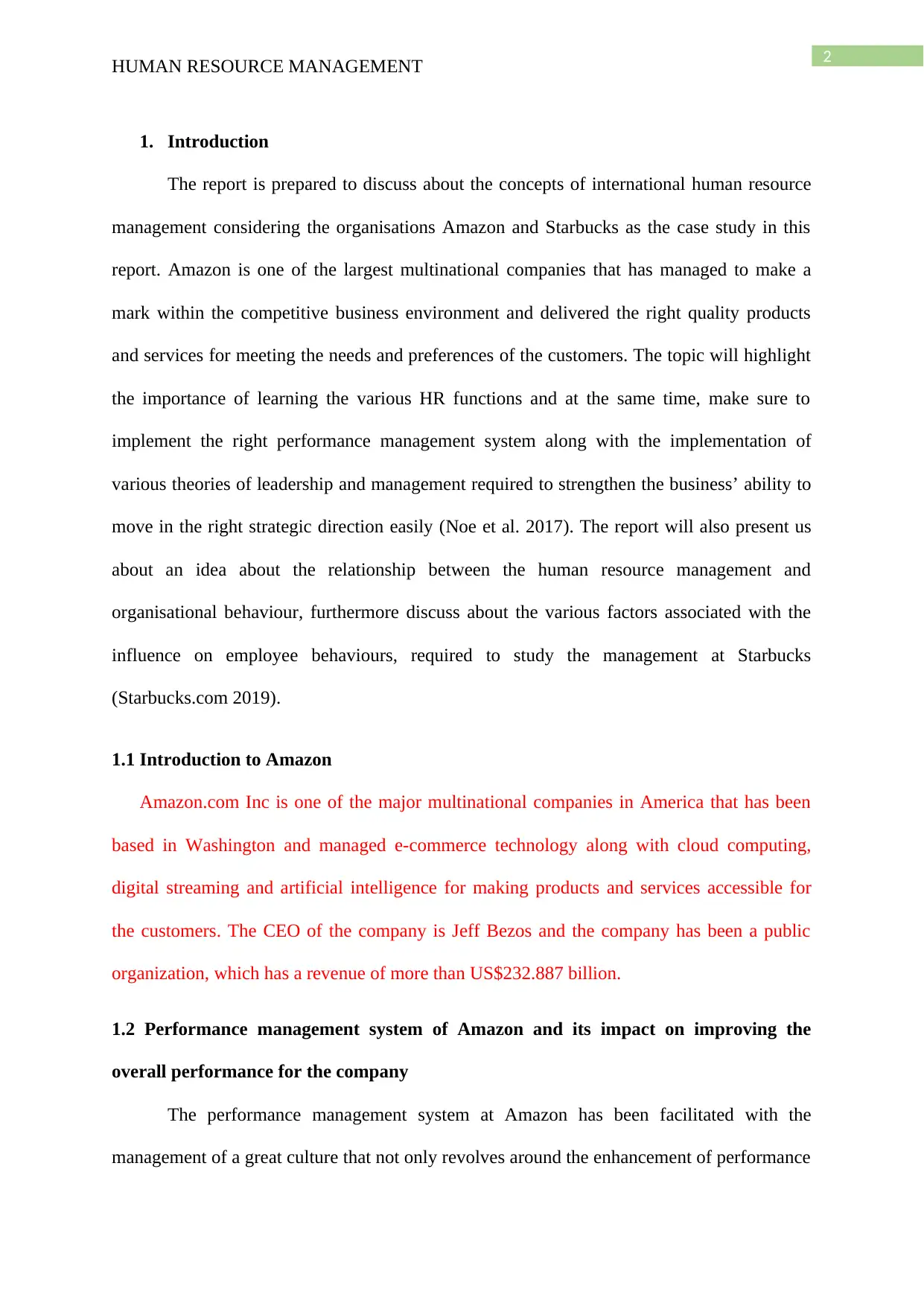
2
HUMAN RESOURCE MANAGEMENT
1. Introduction
The report is prepared to discuss about the concepts of international human resource
management considering the organisations Amazon and Starbucks as the case study in this
report. Amazon is one of the largest multinational companies that has managed to make a
mark within the competitive business environment and delivered the right quality products
and services for meeting the needs and preferences of the customers. The topic will highlight
the importance of learning the various HR functions and at the same time, make sure to
implement the right performance management system along with the implementation of
various theories of leadership and management required to strengthen the business’ ability to
move in the right strategic direction easily (Noe et al. 2017). The report will also present us
about an idea about the relationship between the human resource management and
organisational behaviour, furthermore discuss about the various factors associated with the
influence on employee behaviours, required to study the management at Starbucks
(Starbucks.com 2019).
1.1 Introduction to Amazon
Amazon.com Inc is one of the major multinational companies in America that has been
based in Washington and managed e-commerce technology along with cloud computing,
digital streaming and artificial intelligence for making products and services accessible for
the customers. The CEO of the company is Jeff Bezos and the company has been a public
organization, which has a revenue of more than US$232.887 billion.
1.2 Performance management system of Amazon and its impact on improving the
overall performance for the company
The performance management system at Amazon has been facilitated with the
management of a great culture that not only revolves around the enhancement of performance
HUMAN RESOURCE MANAGEMENT
1. Introduction
The report is prepared to discuss about the concepts of international human resource
management considering the organisations Amazon and Starbucks as the case study in this
report. Amazon is one of the largest multinational companies that has managed to make a
mark within the competitive business environment and delivered the right quality products
and services for meeting the needs and preferences of the customers. The topic will highlight
the importance of learning the various HR functions and at the same time, make sure to
implement the right performance management system along with the implementation of
various theories of leadership and management required to strengthen the business’ ability to
move in the right strategic direction easily (Noe et al. 2017). The report will also present us
about an idea about the relationship between the human resource management and
organisational behaviour, furthermore discuss about the various factors associated with the
influence on employee behaviours, required to study the management at Starbucks
(Starbucks.com 2019).
1.1 Introduction to Amazon
Amazon.com Inc is one of the major multinational companies in America that has been
based in Washington and managed e-commerce technology along with cloud computing,
digital streaming and artificial intelligence for making products and services accessible for
the customers. The CEO of the company is Jeff Bezos and the company has been a public
organization, which has a revenue of more than US$232.887 billion.
1.2 Performance management system of Amazon and its impact on improving the
overall performance for the company
The performance management system at Amazon has been facilitated with the
management of a great culture that not only revolves around the enhancement of performance
⊘ This is a preview!⊘
Do you want full access?
Subscribe today to unlock all pages.

Trusted by 1+ million students worldwide
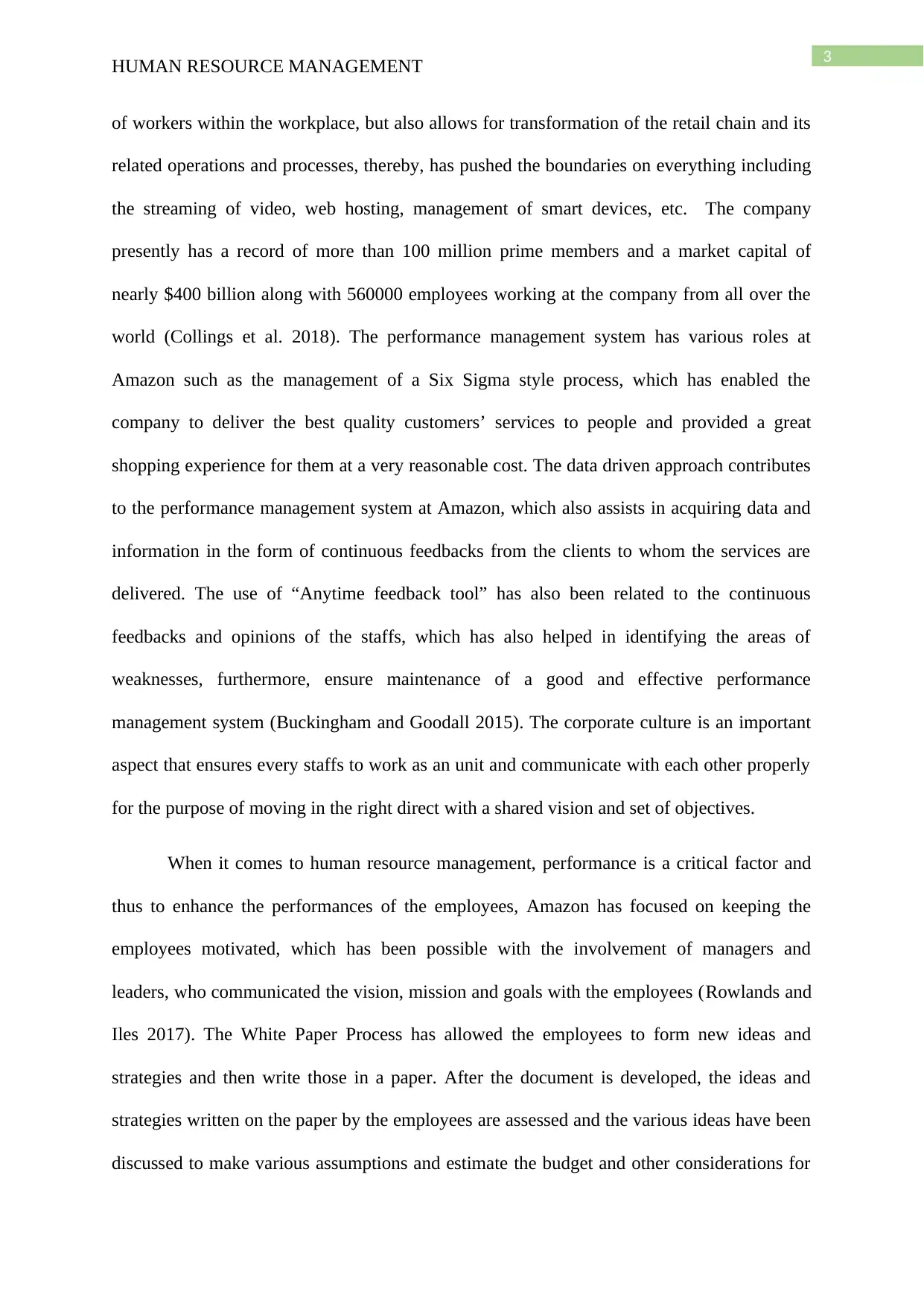
3
HUMAN RESOURCE MANAGEMENT
of workers within the workplace, but also allows for transformation of the retail chain and its
related operations and processes, thereby, has pushed the boundaries on everything including
the streaming of video, web hosting, management of smart devices, etc. The company
presently has a record of more than 100 million prime members and a market capital of
nearly $400 billion along with 560000 employees working at the company from all over the
world (Collings et al. 2018). The performance management system has various roles at
Amazon such as the management of a Six Sigma style process, which has enabled the
company to deliver the best quality customers’ services to people and provided a great
shopping experience for them at a very reasonable cost. The data driven approach contributes
to the performance management system at Amazon, which also assists in acquiring data and
information in the form of continuous feedbacks from the clients to whom the services are
delivered. The use of “Anytime feedback tool” has also been related to the continuous
feedbacks and opinions of the staffs, which has also helped in identifying the areas of
weaknesses, furthermore, ensure maintenance of a good and effective performance
management system (Buckingham and Goodall 2015). The corporate culture is an important
aspect that ensures every staffs to work as an unit and communicate with each other properly
for the purpose of moving in the right direct with a shared vision and set of objectives.
When it comes to human resource management, performance is a critical factor and
thus to enhance the performances of the employees, Amazon has focused on keeping the
employees motivated, which has been possible with the involvement of managers and
leaders, who communicated the vision, mission and goals with the employees (Rowlands and
Iles 2017). The White Paper Process has allowed the employees to form new ideas and
strategies and then write those in a paper. After the document is developed, the ideas and
strategies written on the paper by the employees are assessed and the various ideas have been
discussed to make various assumptions and estimate the budget and other considerations for
HUMAN RESOURCE MANAGEMENT
of workers within the workplace, but also allows for transformation of the retail chain and its
related operations and processes, thereby, has pushed the boundaries on everything including
the streaming of video, web hosting, management of smart devices, etc. The company
presently has a record of more than 100 million prime members and a market capital of
nearly $400 billion along with 560000 employees working at the company from all over the
world (Collings et al. 2018). The performance management system has various roles at
Amazon such as the management of a Six Sigma style process, which has enabled the
company to deliver the best quality customers’ services to people and provided a great
shopping experience for them at a very reasonable cost. The data driven approach contributes
to the performance management system at Amazon, which also assists in acquiring data and
information in the form of continuous feedbacks from the clients to whom the services are
delivered. The use of “Anytime feedback tool” has also been related to the continuous
feedbacks and opinions of the staffs, which has also helped in identifying the areas of
weaknesses, furthermore, ensure maintenance of a good and effective performance
management system (Buckingham and Goodall 2015). The corporate culture is an important
aspect that ensures every staffs to work as an unit and communicate with each other properly
for the purpose of moving in the right direct with a shared vision and set of objectives.
When it comes to human resource management, performance is a critical factor and
thus to enhance the performances of the employees, Amazon has focused on keeping the
employees motivated, which has been possible with the involvement of managers and
leaders, who communicated the vision, mission and goals with the employees (Rowlands and
Iles 2017). The White Paper Process has allowed the employees to form new ideas and
strategies and then write those in a paper. After the document is developed, the ideas and
strategies written on the paper by the employees are assessed and the various ideas have been
discussed to make various assumptions and estimate the budget and other considerations for
Paraphrase This Document
Need a fresh take? Get an instant paraphrase of this document with our AI Paraphraser
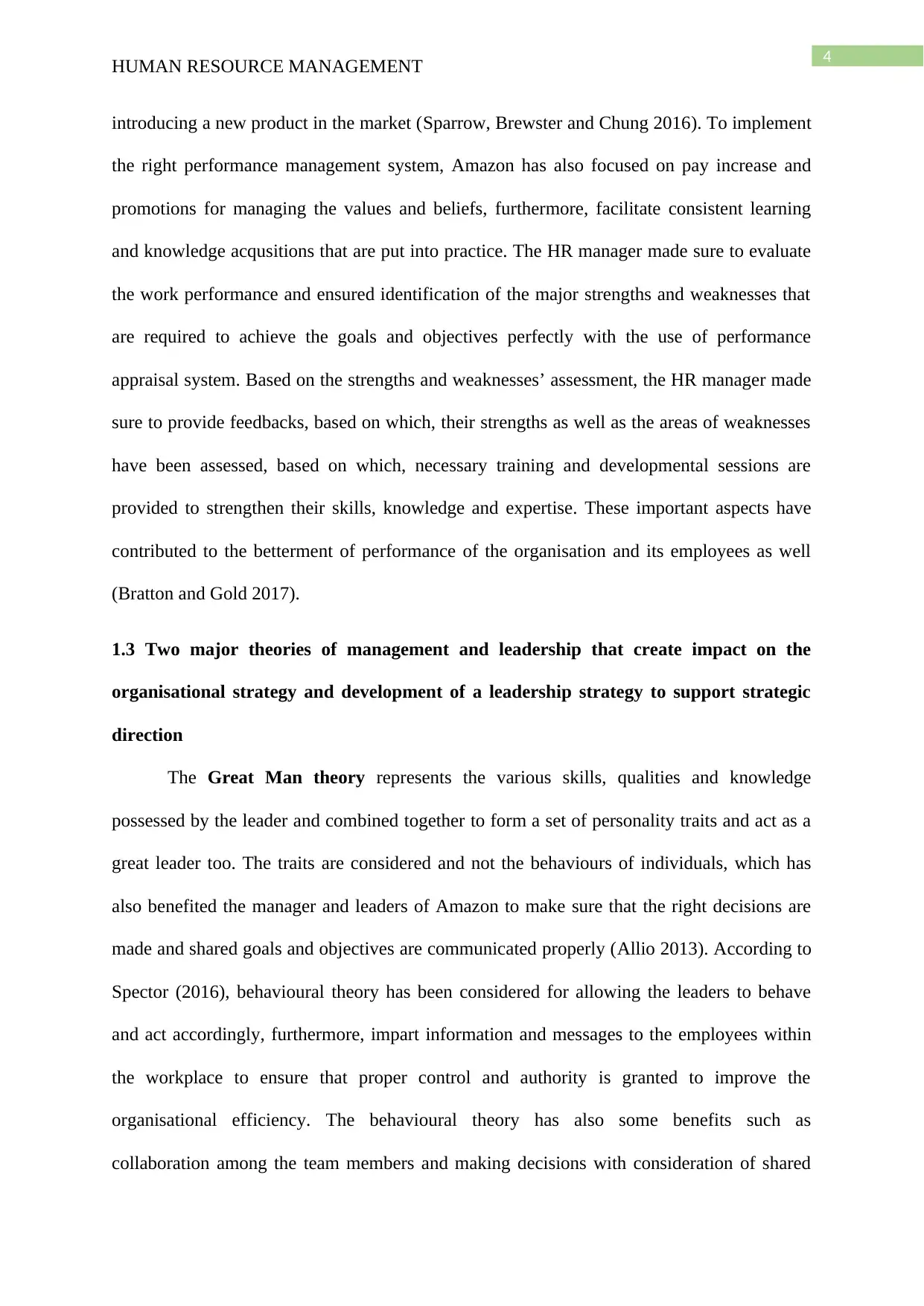
4
HUMAN RESOURCE MANAGEMENT
introducing a new product in the market (Sparrow, Brewster and Chung 2016). To implement
the right performance management system, Amazon has also focused on pay increase and
promotions for managing the values and beliefs, furthermore, facilitate consistent learning
and knowledge acqusitions that are put into practice. The HR manager made sure to evaluate
the work performance and ensured identification of the major strengths and weaknesses that
are required to achieve the goals and objectives perfectly with the use of performance
appraisal system. Based on the strengths and weaknesses’ assessment, the HR manager made
sure to provide feedbacks, based on which, their strengths as well as the areas of weaknesses
have been assessed, based on which, necessary training and developmental sessions are
provided to strengthen their skills, knowledge and expertise. These important aspects have
contributed to the betterment of performance of the organisation and its employees as well
(Bratton and Gold 2017).
1.3 Two major theories of management and leadership that create impact on the
organisational strategy and development of a leadership strategy to support strategic
direction
The Great Man theory represents the various skills, qualities and knowledge
possessed by the leader and combined together to form a set of personality traits and act as a
great leader too. The traits are considered and not the behaviours of individuals, which has
also benefited the manager and leaders of Amazon to make sure that the right decisions are
made and shared goals and objectives are communicated properly (Allio 2013). According to
Spector (2016), behavioural theory has been considered for allowing the leaders to behave
and act accordingly, furthermore, impart information and messages to the employees within
the workplace to ensure that proper control and authority is granted to improve the
organisational efficiency. The behavioural theory has also some benefits such as
collaboration among the team members and making decisions with consideration of shared
HUMAN RESOURCE MANAGEMENT
introducing a new product in the market (Sparrow, Brewster and Chung 2016). To implement
the right performance management system, Amazon has also focused on pay increase and
promotions for managing the values and beliefs, furthermore, facilitate consistent learning
and knowledge acqusitions that are put into practice. The HR manager made sure to evaluate
the work performance and ensured identification of the major strengths and weaknesses that
are required to achieve the goals and objectives perfectly with the use of performance
appraisal system. Based on the strengths and weaknesses’ assessment, the HR manager made
sure to provide feedbacks, based on which, their strengths as well as the areas of weaknesses
have been assessed, based on which, necessary training and developmental sessions are
provided to strengthen their skills, knowledge and expertise. These important aspects have
contributed to the betterment of performance of the organisation and its employees as well
(Bratton and Gold 2017).
1.3 Two major theories of management and leadership that create impact on the
organisational strategy and development of a leadership strategy to support strategic
direction
The Great Man theory represents the various skills, qualities and knowledge
possessed by the leader and combined together to form a set of personality traits and act as a
great leader too. The traits are considered and not the behaviours of individuals, which has
also benefited the manager and leaders of Amazon to make sure that the right decisions are
made and shared goals and objectives are communicated properly (Allio 2013). According to
Spector (2016), behavioural theory has been considered for allowing the leaders to behave
and act accordingly, furthermore, impart information and messages to the employees within
the workplace to ensure that proper control and authority is granted to improve the
organisational efficiency. The behavioural theory has also some benefits such as
collaboration among the team members and making decisions with consideration of shared
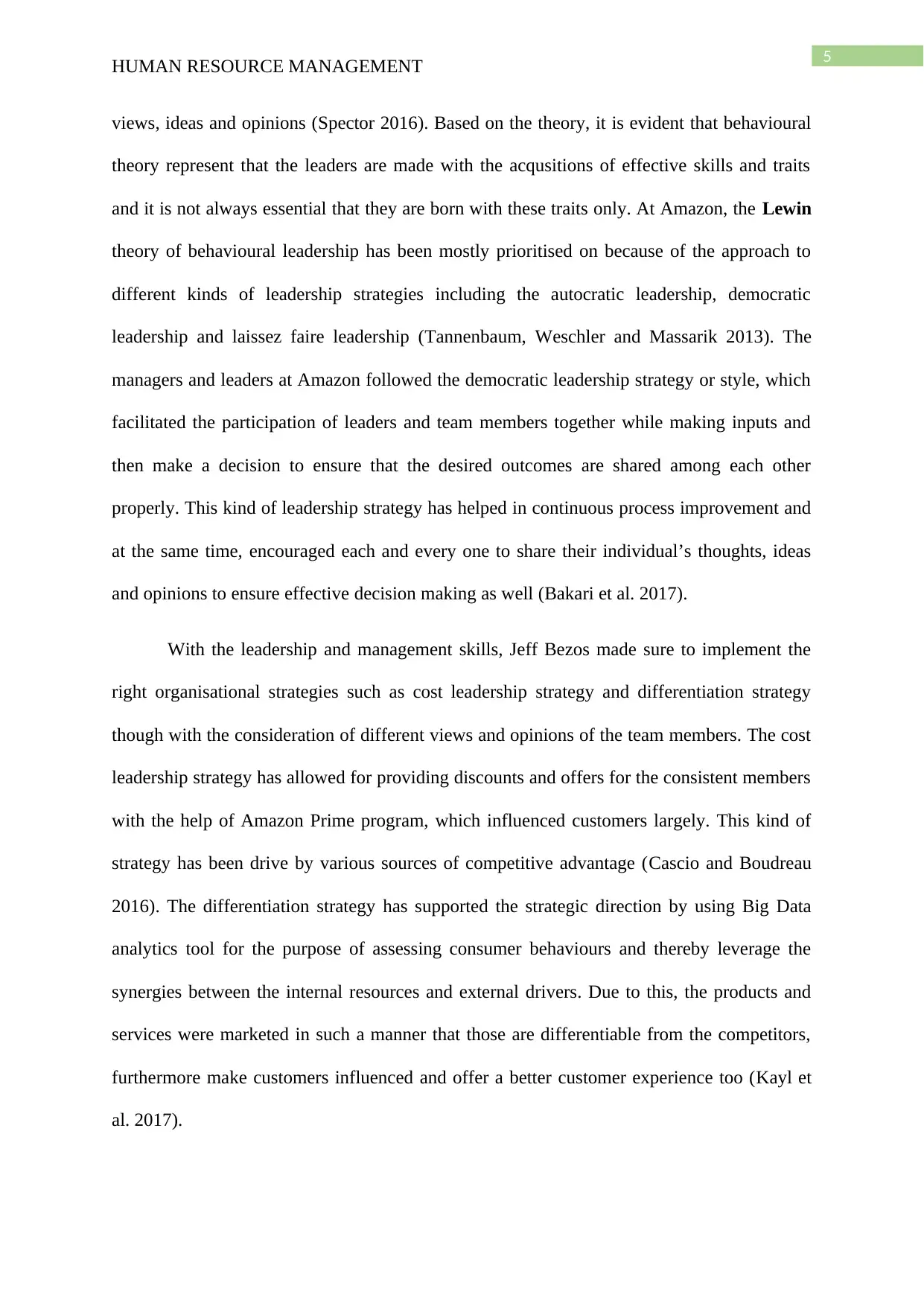
5
HUMAN RESOURCE MANAGEMENT
views, ideas and opinions (Spector 2016). Based on the theory, it is evident that behavioural
theory represent that the leaders are made with the acqusitions of effective skills and traits
and it is not always essential that they are born with these traits only. At Amazon, the Lewin
theory of behavioural leadership has been mostly prioritised on because of the approach to
different kinds of leadership strategies including the autocratic leadership, democratic
leadership and laissez faire leadership (Tannenbaum, Weschler and Massarik 2013). The
managers and leaders at Amazon followed the democratic leadership strategy or style, which
facilitated the participation of leaders and team members together while making inputs and
then make a decision to ensure that the desired outcomes are shared among each other
properly. This kind of leadership strategy has helped in continuous process improvement and
at the same time, encouraged each and every one to share their individual’s thoughts, ideas
and opinions to ensure effective decision making as well (Bakari et al. 2017).
With the leadership and management skills, Jeff Bezos made sure to implement the
right organisational strategies such as cost leadership strategy and differentiation strategy
though with the consideration of different views and opinions of the team members. The cost
leadership strategy has allowed for providing discounts and offers for the consistent members
with the help of Amazon Prime program, which influenced customers largely. This kind of
strategy has been drive by various sources of competitive advantage (Cascio and Boudreau
2016). The differentiation strategy has supported the strategic direction by using Big Data
analytics tool for the purpose of assessing consumer behaviours and thereby leverage the
synergies between the internal resources and external drivers. Due to this, the products and
services were marketed in such a manner that those are differentiable from the competitors,
furthermore make customers influenced and offer a better customer experience too (Kayl et
al. 2017).
HUMAN RESOURCE MANAGEMENT
views, ideas and opinions (Spector 2016). Based on the theory, it is evident that behavioural
theory represent that the leaders are made with the acqusitions of effective skills and traits
and it is not always essential that they are born with these traits only. At Amazon, the Lewin
theory of behavioural leadership has been mostly prioritised on because of the approach to
different kinds of leadership strategies including the autocratic leadership, democratic
leadership and laissez faire leadership (Tannenbaum, Weschler and Massarik 2013). The
managers and leaders at Amazon followed the democratic leadership strategy or style, which
facilitated the participation of leaders and team members together while making inputs and
then make a decision to ensure that the desired outcomes are shared among each other
properly. This kind of leadership strategy has helped in continuous process improvement and
at the same time, encouraged each and every one to share their individual’s thoughts, ideas
and opinions to ensure effective decision making as well (Bakari et al. 2017).
With the leadership and management skills, Jeff Bezos made sure to implement the
right organisational strategies such as cost leadership strategy and differentiation strategy
though with the consideration of different views and opinions of the team members. The cost
leadership strategy has allowed for providing discounts and offers for the consistent members
with the help of Amazon Prime program, which influenced customers largely. This kind of
strategy has been drive by various sources of competitive advantage (Cascio and Boudreau
2016). The differentiation strategy has supported the strategic direction by using Big Data
analytics tool for the purpose of assessing consumer behaviours and thereby leverage the
synergies between the internal resources and external drivers. Due to this, the products and
services were marketed in such a manner that those are differentiable from the competitors,
furthermore make customers influenced and offer a better customer experience too (Kayl et
al. 2017).
⊘ This is a preview!⊘
Do you want full access?
Subscribe today to unlock all pages.

Trusted by 1+ million students worldwide
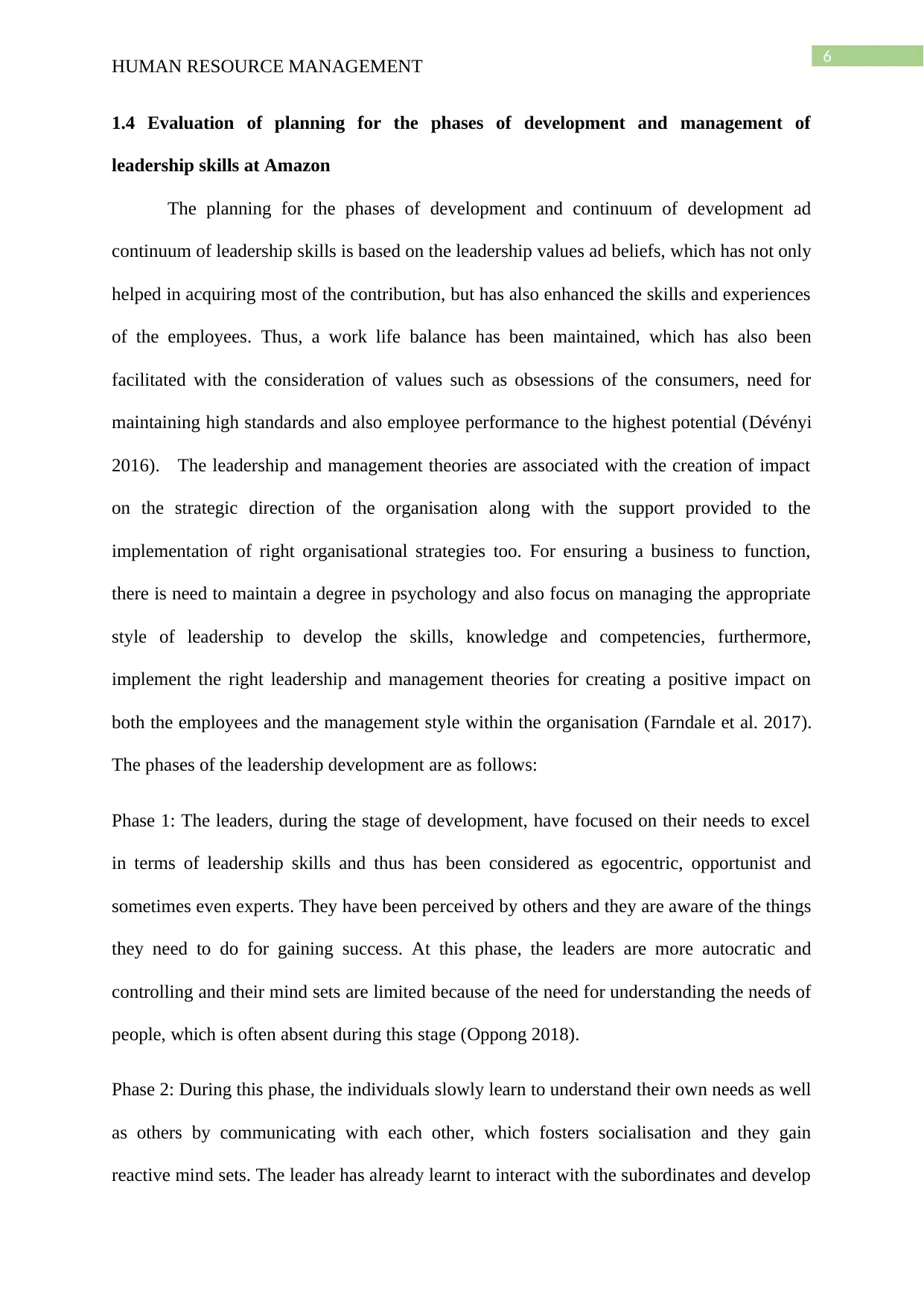
6
HUMAN RESOURCE MANAGEMENT
1.4 Evaluation of planning for the phases of development and management of
leadership skills at Amazon
The planning for the phases of development and continuum of development ad
continuum of leadership skills is based on the leadership values ad beliefs, which has not only
helped in acquiring most of the contribution, but has also enhanced the skills and experiences
of the employees. Thus, a work life balance has been maintained, which has also been
facilitated with the consideration of values such as obsessions of the consumers, need for
maintaining high standards and also employee performance to the highest potential (Dévényi
2016). The leadership and management theories are associated with the creation of impact
on the strategic direction of the organisation along with the support provided to the
implementation of right organisational strategies too. For ensuring a business to function,
there is need to maintain a degree in psychology and also focus on managing the appropriate
style of leadership to develop the skills, knowledge and competencies, furthermore,
implement the right leadership and management theories for creating a positive impact on
both the employees and the management style within the organisation (Farndale et al. 2017).
The phases of the leadership development are as follows:
Phase 1: The leaders, during the stage of development, have focused on their needs to excel
in terms of leadership skills and thus has been considered as egocentric, opportunist and
sometimes even experts. They have been perceived by others and they are aware of the things
they need to do for gaining success. At this phase, the leaders are more autocratic and
controlling and their mind sets are limited because of the need for understanding the needs of
people, which is often absent during this stage (Oppong 2018).
Phase 2: During this phase, the individuals slowly learn to understand their own needs as well
as others by communicating with each other, which fosters socialisation and they gain
reactive mind sets. The leader has already learnt to interact with the subordinates and develop
HUMAN RESOURCE MANAGEMENT
1.4 Evaluation of planning for the phases of development and management of
leadership skills at Amazon
The planning for the phases of development and continuum of development ad
continuum of leadership skills is based on the leadership values ad beliefs, which has not only
helped in acquiring most of the contribution, but has also enhanced the skills and experiences
of the employees. Thus, a work life balance has been maintained, which has also been
facilitated with the consideration of values such as obsessions of the consumers, need for
maintaining high standards and also employee performance to the highest potential (Dévényi
2016). The leadership and management theories are associated with the creation of impact
on the strategic direction of the organisation along with the support provided to the
implementation of right organisational strategies too. For ensuring a business to function,
there is need to maintain a degree in psychology and also focus on managing the appropriate
style of leadership to develop the skills, knowledge and competencies, furthermore,
implement the right leadership and management theories for creating a positive impact on
both the employees and the management style within the organisation (Farndale et al. 2017).
The phases of the leadership development are as follows:
Phase 1: The leaders, during the stage of development, have focused on their needs to excel
in terms of leadership skills and thus has been considered as egocentric, opportunist and
sometimes even experts. They have been perceived by others and they are aware of the things
they need to do for gaining success. At this phase, the leaders are more autocratic and
controlling and their mind sets are limited because of the need for understanding the needs of
people, which is often absent during this stage (Oppong 2018).
Phase 2: During this phase, the individuals slowly learn to understand their own needs as well
as others by communicating with each other, which fosters socialisation and they gain
reactive mind sets. The leader has already learnt to interact with the subordinates and develop
Paraphrase This Document
Need a fresh take? Get an instant paraphrase of this document with our AI Paraphraser
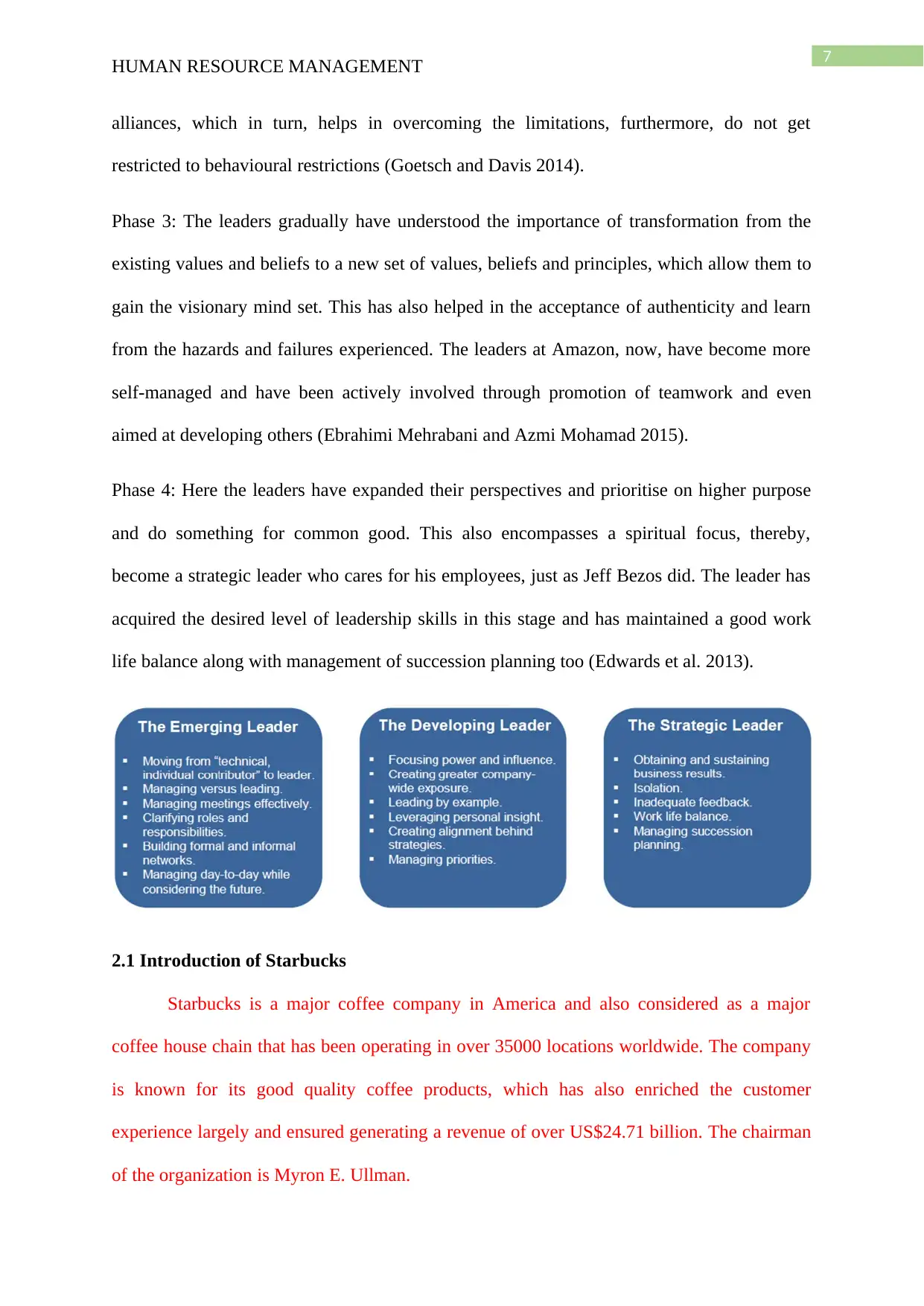
7
HUMAN RESOURCE MANAGEMENT
alliances, which in turn, helps in overcoming the limitations, furthermore, do not get
restricted to behavioural restrictions (Goetsch and Davis 2014).
Phase 3: The leaders gradually have understood the importance of transformation from the
existing values and beliefs to a new set of values, beliefs and principles, which allow them to
gain the visionary mind set. This has also helped in the acceptance of authenticity and learn
from the hazards and failures experienced. The leaders at Amazon, now, have become more
self-managed and have been actively involved through promotion of teamwork and even
aimed at developing others (Ebrahimi Mehrabani and Azmi Mohamad 2015).
Phase 4: Here the leaders have expanded their perspectives and prioritise on higher purpose
and do something for common good. This also encompasses a spiritual focus, thereby,
become a strategic leader who cares for his employees, just as Jeff Bezos did. The leader has
acquired the desired level of leadership skills in this stage and has maintained a good work
life balance along with management of succession planning too (Edwards et al. 2013).
2.1 Introduction of Starbucks
Starbucks is a major coffee company in America and also considered as a major
coffee house chain that has been operating in over 35000 locations worldwide. The company
is known for its good quality coffee products, which has also enriched the customer
experience largely and ensured generating a revenue of over US$24.71 billion. The chairman
of the organization is Myron E. Ullman.
HUMAN RESOURCE MANAGEMENT
alliances, which in turn, helps in overcoming the limitations, furthermore, do not get
restricted to behavioural restrictions (Goetsch and Davis 2014).
Phase 3: The leaders gradually have understood the importance of transformation from the
existing values and beliefs to a new set of values, beliefs and principles, which allow them to
gain the visionary mind set. This has also helped in the acceptance of authenticity and learn
from the hazards and failures experienced. The leaders at Amazon, now, have become more
self-managed and have been actively involved through promotion of teamwork and even
aimed at developing others (Ebrahimi Mehrabani and Azmi Mohamad 2015).
Phase 4: Here the leaders have expanded their perspectives and prioritise on higher purpose
and do something for common good. This also encompasses a spiritual focus, thereby,
become a strategic leader who cares for his employees, just as Jeff Bezos did. The leader has
acquired the desired level of leadership skills in this stage and has maintained a good work
life balance along with management of succession planning too (Edwards et al. 2013).
2.1 Introduction of Starbucks
Starbucks is a major coffee company in America and also considered as a major
coffee house chain that has been operating in over 35000 locations worldwide. The company
is known for its good quality coffee products, which has also enriched the customer
experience largely and ensured generating a revenue of over US$24.71 billion. The chairman
of the organization is Myron E. Ullman.
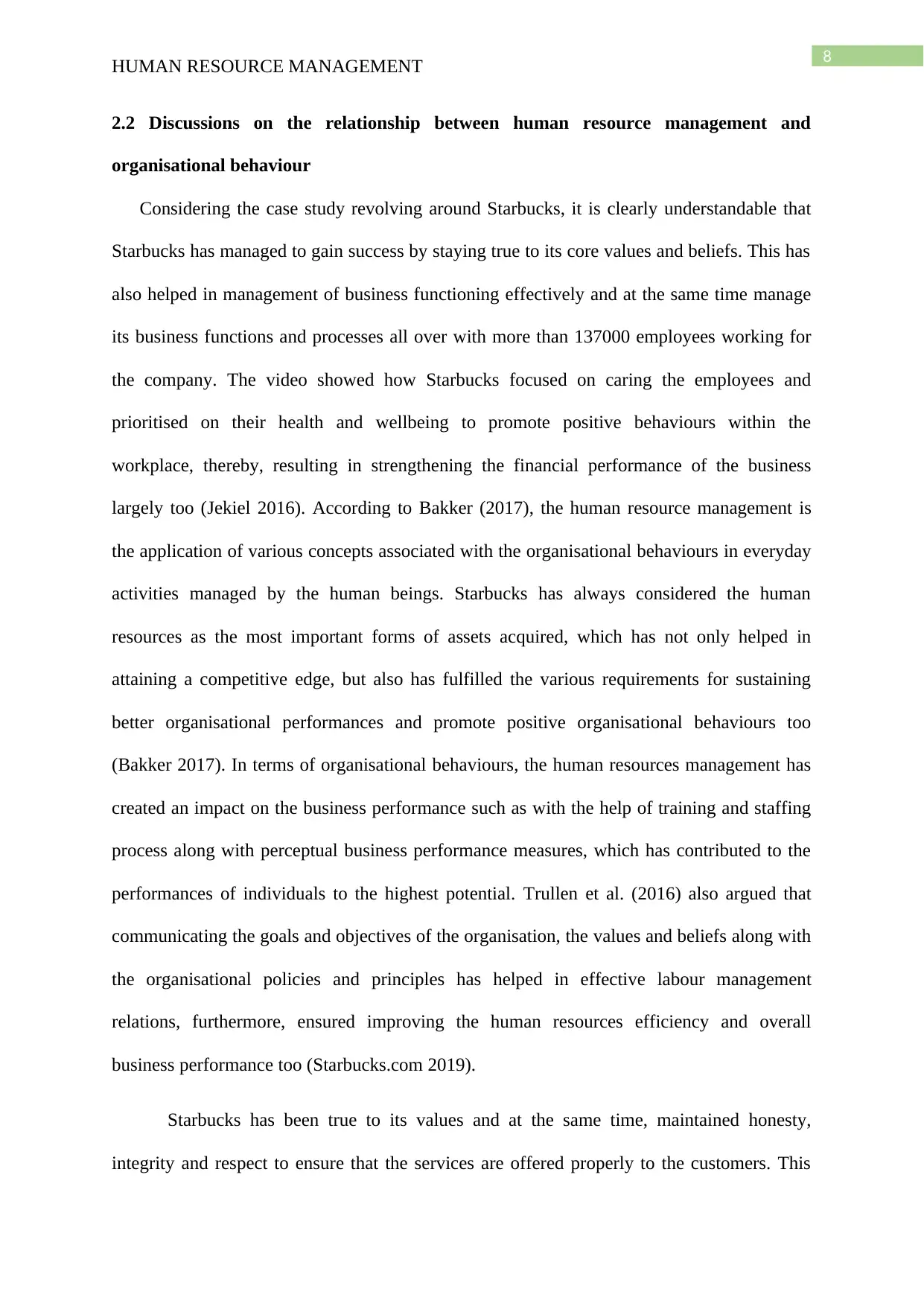
8
HUMAN RESOURCE MANAGEMENT
2.2 Discussions on the relationship between human resource management and
organisational behaviour
Considering the case study revolving around Starbucks, it is clearly understandable that
Starbucks has managed to gain success by staying true to its core values and beliefs. This has
also helped in management of business functioning effectively and at the same time manage
its business functions and processes all over with more than 137000 employees working for
the company. The video showed how Starbucks focused on caring the employees and
prioritised on their health and wellbeing to promote positive behaviours within the
workplace, thereby, resulting in strengthening the financial performance of the business
largely too (Jekiel 2016). According to Bakker (2017), the human resource management is
the application of various concepts associated with the organisational behaviours in everyday
activities managed by the human beings. Starbucks has always considered the human
resources as the most important forms of assets acquired, which has not only helped in
attaining a competitive edge, but also has fulfilled the various requirements for sustaining
better organisational performances and promote positive organisational behaviours too
(Bakker 2017). In terms of organisational behaviours, the human resources management has
created an impact on the business performance such as with the help of training and staffing
process along with perceptual business performance measures, which has contributed to the
performances of individuals to the highest potential. Trullen et al. (2016) also argued that
communicating the goals and objectives of the organisation, the values and beliefs along with
the organisational policies and principles has helped in effective labour management
relations, furthermore, ensured improving the human resources efficiency and overall
business performance too (Starbucks.com 2019).
Starbucks has been true to its values and at the same time, maintained honesty,
integrity and respect to ensure that the services are offered properly to the customers. This
HUMAN RESOURCE MANAGEMENT
2.2 Discussions on the relationship between human resource management and
organisational behaviour
Considering the case study revolving around Starbucks, it is clearly understandable that
Starbucks has managed to gain success by staying true to its core values and beliefs. This has
also helped in management of business functioning effectively and at the same time manage
its business functions and processes all over with more than 137000 employees working for
the company. The video showed how Starbucks focused on caring the employees and
prioritised on their health and wellbeing to promote positive behaviours within the
workplace, thereby, resulting in strengthening the financial performance of the business
largely too (Jekiel 2016). According to Bakker (2017), the human resource management is
the application of various concepts associated with the organisational behaviours in everyday
activities managed by the human beings. Starbucks has always considered the human
resources as the most important forms of assets acquired, which has not only helped in
attaining a competitive edge, but also has fulfilled the various requirements for sustaining
better organisational performances and promote positive organisational behaviours too
(Bakker 2017). In terms of organisational behaviours, the human resources management has
created an impact on the business performance such as with the help of training and staffing
process along with perceptual business performance measures, which has contributed to the
performances of individuals to the highest potential. Trullen et al. (2016) also argued that
communicating the goals and objectives of the organisation, the values and beliefs along with
the organisational policies and principles has helped in effective labour management
relations, furthermore, ensured improving the human resources efficiency and overall
business performance too (Starbucks.com 2019).
Starbucks has been true to its values and at the same time, maintained honesty,
integrity and respect to ensure that the services are offered properly to the customers. This
⊘ This is a preview!⊘
Do you want full access?
Subscribe today to unlock all pages.

Trusted by 1+ million students worldwide
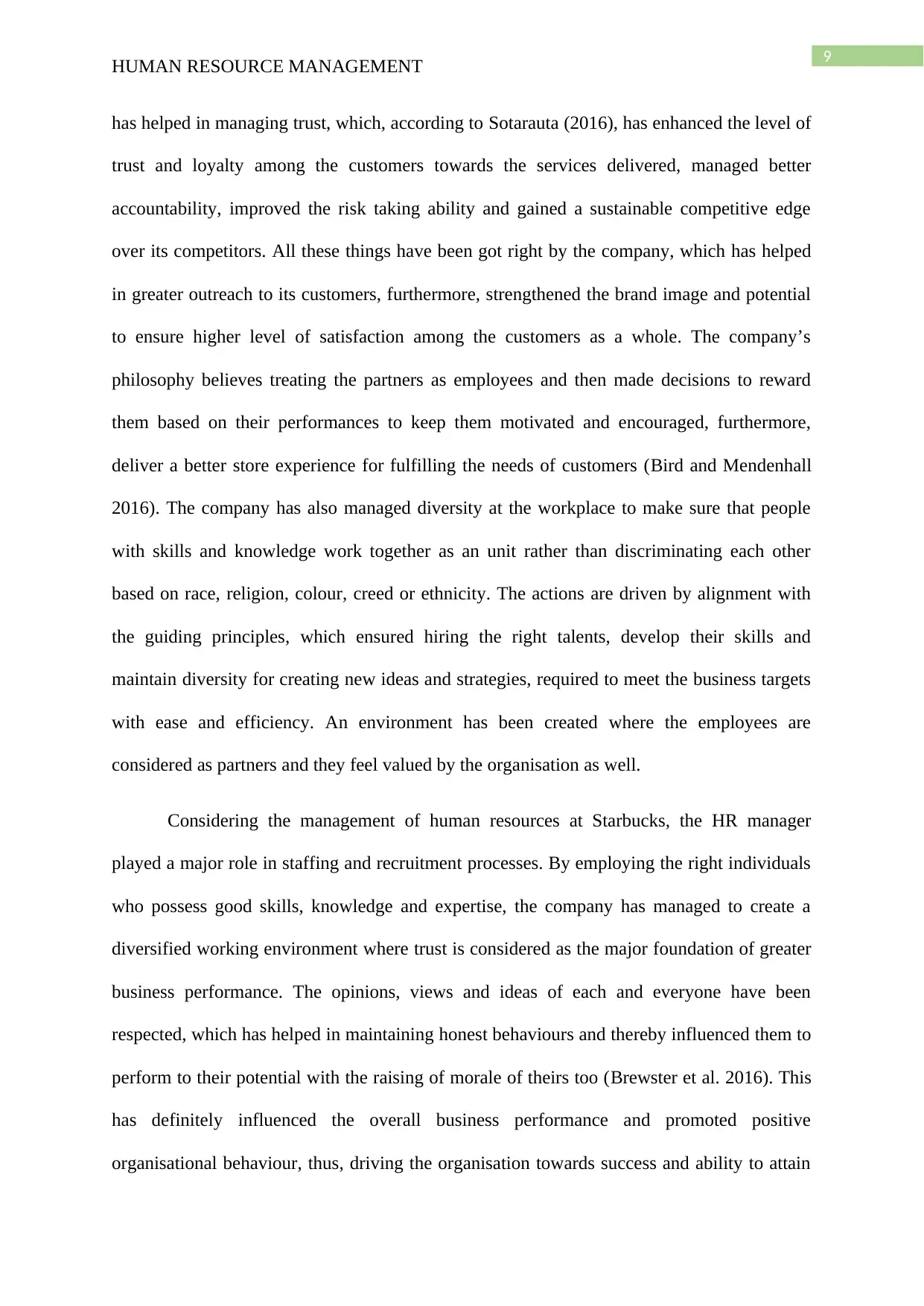
9
HUMAN RESOURCE MANAGEMENT
has helped in managing trust, which, according to Sotarauta (2016), has enhanced the level of
trust and loyalty among the customers towards the services delivered, managed better
accountability, improved the risk taking ability and gained a sustainable competitive edge
over its competitors. All these things have been got right by the company, which has helped
in greater outreach to its customers, furthermore, strengthened the brand image and potential
to ensure higher level of satisfaction among the customers as a whole. The company’s
philosophy believes treating the partners as employees and then made decisions to reward
them based on their performances to keep them motivated and encouraged, furthermore,
deliver a better store experience for fulfilling the needs of customers (Bird and Mendenhall
2016). The company has also managed diversity at the workplace to make sure that people
with skills and knowledge work together as an unit rather than discriminating each other
based on race, religion, colour, creed or ethnicity. The actions are driven by alignment with
the guiding principles, which ensured hiring the right talents, develop their skills and
maintain diversity for creating new ideas and strategies, required to meet the business targets
with ease and efficiency. An environment has been created where the employees are
considered as partners and they feel valued by the organisation as well.
Considering the management of human resources at Starbucks, the HR manager
played a major role in staffing and recruitment processes. By employing the right individuals
who possess good skills, knowledge and expertise, the company has managed to create a
diversified working environment where trust is considered as the major foundation of greater
business performance. The opinions, views and ideas of each and everyone have been
respected, which has helped in maintaining honest behaviours and thereby influenced them to
perform to their potential with the raising of morale of theirs too (Brewster et al. 2016). This
has definitely influenced the overall business performance and promoted positive
organisational behaviour, thus, driving the organisation towards success and ability to attain
HUMAN RESOURCE MANAGEMENT
has helped in managing trust, which, according to Sotarauta (2016), has enhanced the level of
trust and loyalty among the customers towards the services delivered, managed better
accountability, improved the risk taking ability and gained a sustainable competitive edge
over its competitors. All these things have been got right by the company, which has helped
in greater outreach to its customers, furthermore, strengthened the brand image and potential
to ensure higher level of satisfaction among the customers as a whole. The company’s
philosophy believes treating the partners as employees and then made decisions to reward
them based on their performances to keep them motivated and encouraged, furthermore,
deliver a better store experience for fulfilling the needs of customers (Bird and Mendenhall
2016). The company has also managed diversity at the workplace to make sure that people
with skills and knowledge work together as an unit rather than discriminating each other
based on race, religion, colour, creed or ethnicity. The actions are driven by alignment with
the guiding principles, which ensured hiring the right talents, develop their skills and
maintain diversity for creating new ideas and strategies, required to meet the business targets
with ease and efficiency. An environment has been created where the employees are
considered as partners and they feel valued by the organisation as well.
Considering the management of human resources at Starbucks, the HR manager
played a major role in staffing and recruitment processes. By employing the right individuals
who possess good skills, knowledge and expertise, the company has managed to create a
diversified working environment where trust is considered as the major foundation of greater
business performance. The opinions, views and ideas of each and everyone have been
respected, which has helped in maintaining honest behaviours and thereby influenced them to
perform to their potential with the raising of morale of theirs too (Brewster et al. 2016). This
has definitely influenced the overall business performance and promoted positive
organisational behaviour, thus, driving the organisation towards success and ability to attain
Paraphrase This Document
Need a fresh take? Get an instant paraphrase of this document with our AI Paraphraser
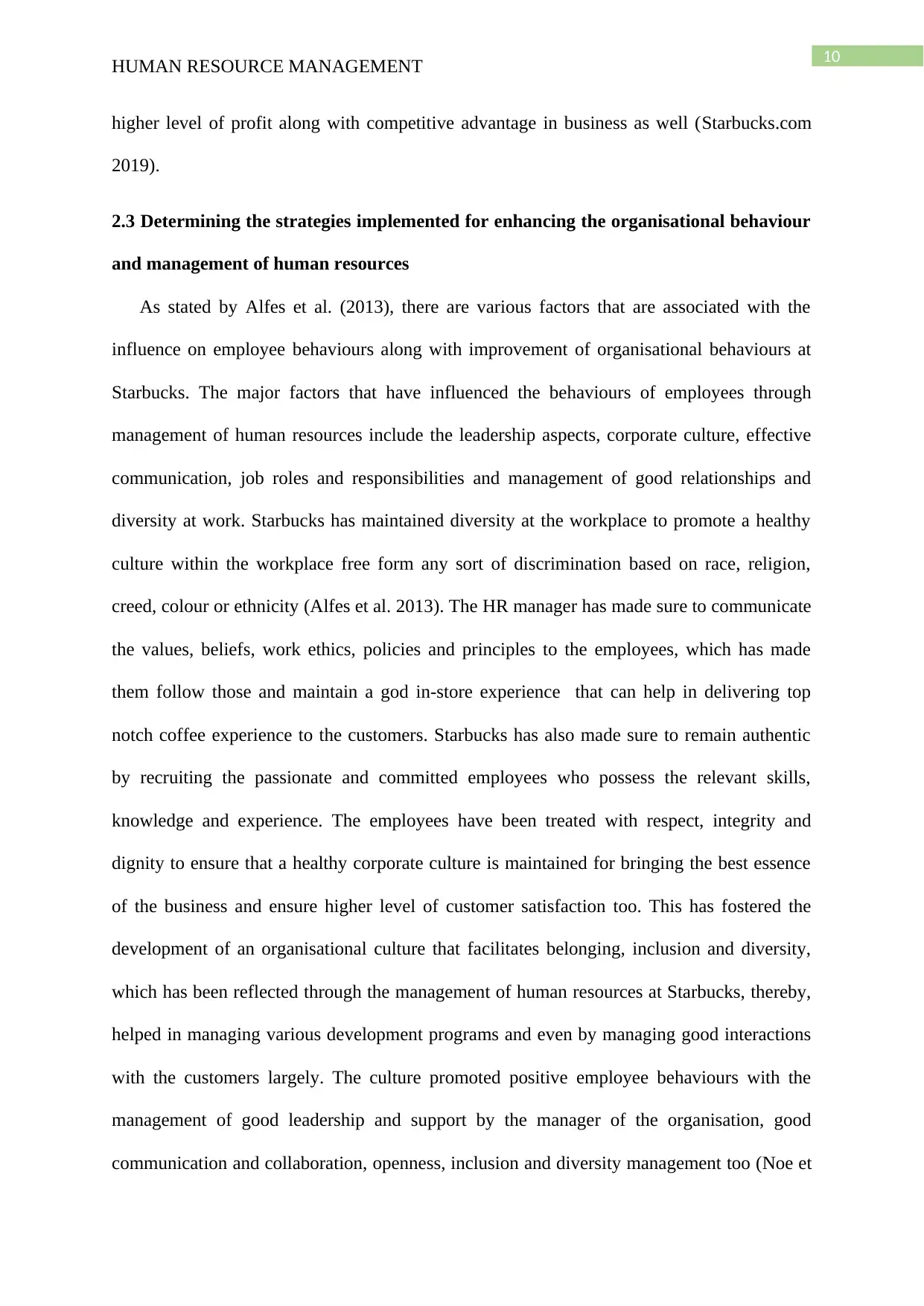
10
HUMAN RESOURCE MANAGEMENT
higher level of profit along with competitive advantage in business as well (Starbucks.com
2019).
2.3 Determining the strategies implemented for enhancing the organisational behaviour
and management of human resources
As stated by Alfes et al. (2013), there are various factors that are associated with the
influence on employee behaviours along with improvement of organisational behaviours at
Starbucks. The major factors that have influenced the behaviours of employees through
management of human resources include the leadership aspects, corporate culture, effective
communication, job roles and responsibilities and management of good relationships and
diversity at work. Starbucks has maintained diversity at the workplace to promote a healthy
culture within the workplace free form any sort of discrimination based on race, religion,
creed, colour or ethnicity (Alfes et al. 2013). The HR manager has made sure to communicate
the values, beliefs, work ethics, policies and principles to the employees, which has made
them follow those and maintain a god in-store experience that can help in delivering top
notch coffee experience to the customers. Starbucks has also made sure to remain authentic
by recruiting the passionate and committed employees who possess the relevant skills,
knowledge and experience. The employees have been treated with respect, integrity and
dignity to ensure that a healthy corporate culture is maintained for bringing the best essence
of the business and ensure higher level of customer satisfaction too. This has fostered the
development of an organisational culture that facilitates belonging, inclusion and diversity,
which has been reflected through the management of human resources at Starbucks, thereby,
helped in managing various development programs and even by managing good interactions
with the customers largely. The culture promoted positive employee behaviours with the
management of good leadership and support by the manager of the organisation, good
communication and collaboration, openness, inclusion and diversity management too (Noe et
HUMAN RESOURCE MANAGEMENT
higher level of profit along with competitive advantage in business as well (Starbucks.com
2019).
2.3 Determining the strategies implemented for enhancing the organisational behaviour
and management of human resources
As stated by Alfes et al. (2013), there are various factors that are associated with the
influence on employee behaviours along with improvement of organisational behaviours at
Starbucks. The major factors that have influenced the behaviours of employees through
management of human resources include the leadership aspects, corporate culture, effective
communication, job roles and responsibilities and management of good relationships and
diversity at work. Starbucks has maintained diversity at the workplace to promote a healthy
culture within the workplace free form any sort of discrimination based on race, religion,
creed, colour or ethnicity (Alfes et al. 2013). The HR manager has made sure to communicate
the values, beliefs, work ethics, policies and principles to the employees, which has made
them follow those and maintain a god in-store experience that can help in delivering top
notch coffee experience to the customers. Starbucks has also made sure to remain authentic
by recruiting the passionate and committed employees who possess the relevant skills,
knowledge and experience. The employees have been treated with respect, integrity and
dignity to ensure that a healthy corporate culture is maintained for bringing the best essence
of the business and ensure higher level of customer satisfaction too. This has fostered the
development of an organisational culture that facilitates belonging, inclusion and diversity,
which has been reflected through the management of human resources at Starbucks, thereby,
helped in managing various development programs and even by managing good interactions
with the customers largely. The culture promoted positive employee behaviours with the
management of good leadership and support by the manager of the organisation, good
communication and collaboration, openness, inclusion and diversity management too (Noe et
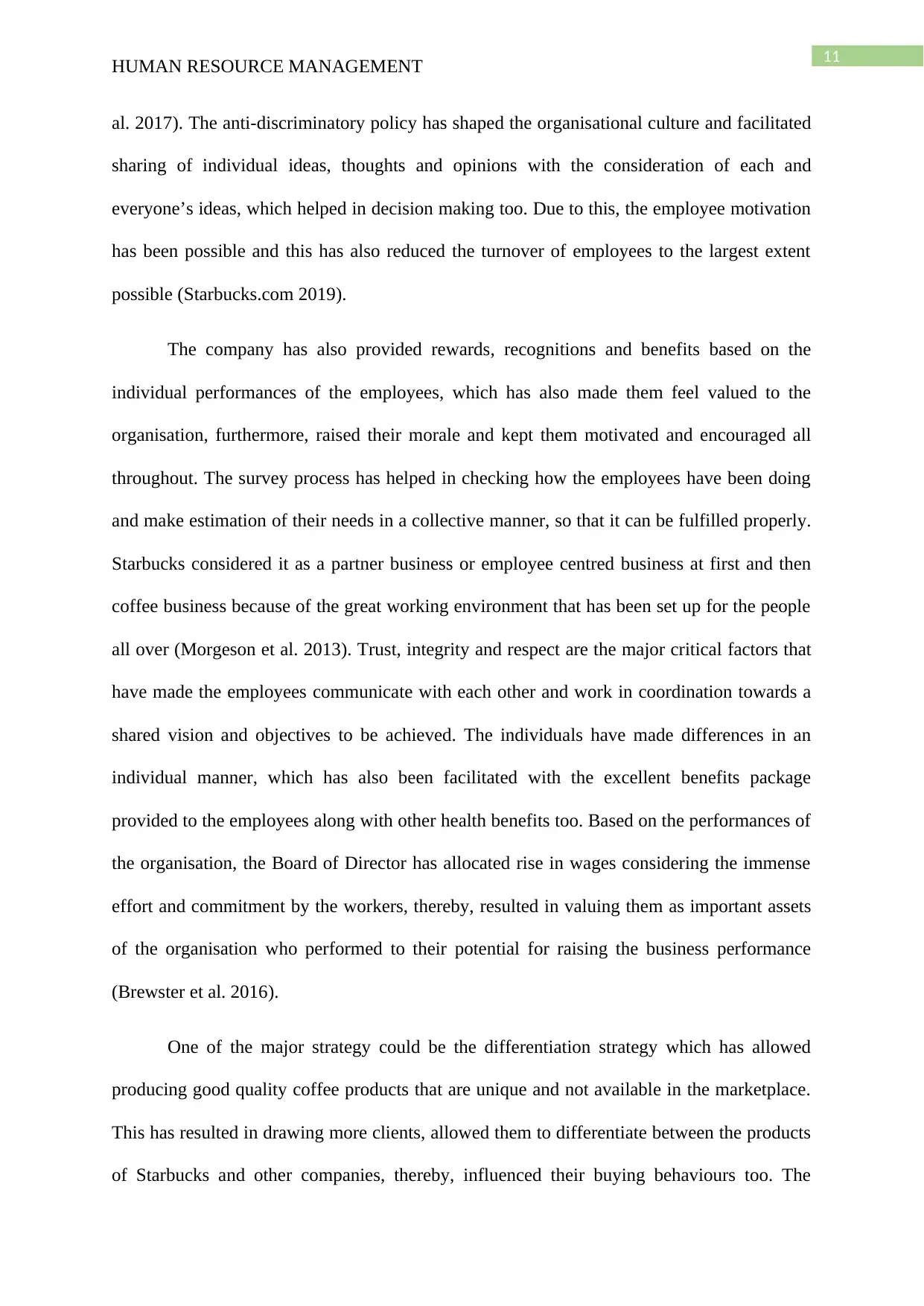
11
HUMAN RESOURCE MANAGEMENT
al. 2017). The anti-discriminatory policy has shaped the organisational culture and facilitated
sharing of individual ideas, thoughts and opinions with the consideration of each and
everyone’s ideas, which helped in decision making too. Due to this, the employee motivation
has been possible and this has also reduced the turnover of employees to the largest extent
possible (Starbucks.com 2019).
The company has also provided rewards, recognitions and benefits based on the
individual performances of the employees, which has also made them feel valued to the
organisation, furthermore, raised their morale and kept them motivated and encouraged all
throughout. The survey process has helped in checking how the employees have been doing
and make estimation of their needs in a collective manner, so that it can be fulfilled properly.
Starbucks considered it as a partner business or employee centred business at first and then
coffee business because of the great working environment that has been set up for the people
all over (Morgeson et al. 2013). Trust, integrity and respect are the major critical factors that
have made the employees communicate with each other and work in coordination towards a
shared vision and objectives to be achieved. The individuals have made differences in an
individual manner, which has also been facilitated with the excellent benefits package
provided to the employees along with other health benefits too. Based on the performances of
the organisation, the Board of Director has allocated rise in wages considering the immense
effort and commitment by the workers, thereby, resulted in valuing them as important assets
of the organisation who performed to their potential for raising the business performance
(Brewster et al. 2016).
One of the major strategy could be the differentiation strategy which has allowed
producing good quality coffee products that are unique and not available in the marketplace.
This has resulted in drawing more clients, allowed them to differentiate between the products
of Starbucks and other companies, thereby, influenced their buying behaviours too. The
HUMAN RESOURCE MANAGEMENT
al. 2017). The anti-discriminatory policy has shaped the organisational culture and facilitated
sharing of individual ideas, thoughts and opinions with the consideration of each and
everyone’s ideas, which helped in decision making too. Due to this, the employee motivation
has been possible and this has also reduced the turnover of employees to the largest extent
possible (Starbucks.com 2019).
The company has also provided rewards, recognitions and benefits based on the
individual performances of the employees, which has also made them feel valued to the
organisation, furthermore, raised their morale and kept them motivated and encouraged all
throughout. The survey process has helped in checking how the employees have been doing
and make estimation of their needs in a collective manner, so that it can be fulfilled properly.
Starbucks considered it as a partner business or employee centred business at first and then
coffee business because of the great working environment that has been set up for the people
all over (Morgeson et al. 2013). Trust, integrity and respect are the major critical factors that
have made the employees communicate with each other and work in coordination towards a
shared vision and objectives to be achieved. The individuals have made differences in an
individual manner, which has also been facilitated with the excellent benefits package
provided to the employees along with other health benefits too. Based on the performances of
the organisation, the Board of Director has allocated rise in wages considering the immense
effort and commitment by the workers, thereby, resulted in valuing them as important assets
of the organisation who performed to their potential for raising the business performance
(Brewster et al. 2016).
One of the major strategy could be the differentiation strategy which has allowed
producing good quality coffee products that are unique and not available in the marketplace.
This has resulted in drawing more clients, allowed them to differentiate between the products
of Starbucks and other companies, thereby, influenced their buying behaviours too. The
⊘ This is a preview!⊘
Do you want full access?
Subscribe today to unlock all pages.

Trusted by 1+ million students worldwide
1 out of 17
Related Documents
Your All-in-One AI-Powered Toolkit for Academic Success.
+13062052269
info@desklib.com
Available 24*7 on WhatsApp / Email
![[object Object]](/_next/static/media/star-bottom.7253800d.svg)
Unlock your academic potential
Copyright © 2020–2025 A2Z Services. All Rights Reserved. Developed and managed by ZUCOL.





